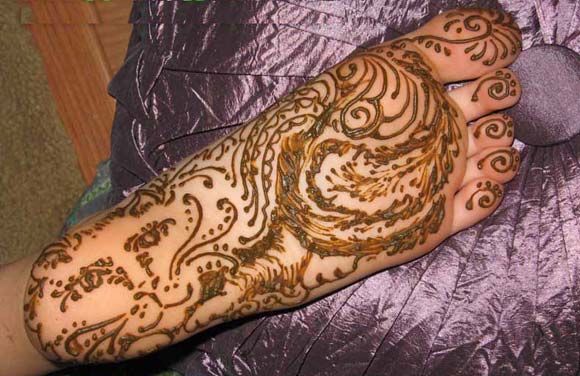FWP:
SETS == IZAFAT;
JO; KYA; MUSHAIRAH
HENNA:
{18,4}
In the first line the word chosen for 'tomb', mashhad , comes from the same root as shahīd and shahādat , and applies especially to the tomb of a martyr (see the definition above); it thus emphasizes the lover's status as a literal 'martyr' to his passion. The use of jo leaves open the question of what use will be made in the second line of the henna fields around the lover's tomb: the jo might mean 'since' and thus suggest a cause and effect relationship, or it might simply gesture toward the henna itself ('the way', 'in that'). (For more on the versatility of jo , see {12,2}.)
Then in the second line, the clever placement of the two iẓāfat construction gives us the 'killing of the longing for foot-kissing'. This can mean either a killing done 'by' the longing-- that is, the killing of the lover by his unbearable longing for foot-kissing; or else a killing done 'to' the longing-- that is, the killing or suppressing of the lover's longing for foot-kissing.
Then, of course, in the way characteristic of the 'kya effect', the second line can be taken either as exclamatory ('to what an extent, how extremely!') or interrogative ('to what extent?'). Here are some possible readings:
=How grievously the lover has been 'killed' or ruined by his longing for foot-kissing! (All that henna testifies to his fatal, unfulfilled passion.)
=How grievously the longing for foot-kissing has been 'killed' or suppressed! (The longing for foot-kissing, because of (or despite) its fierce suppression, has emerged in the form of henna.)
=To what extent has the lover been killed by his longing for foot-kissing? (To the wondering passerby, all that henna seems to suggest the nature of the lover's torment.)
=To what extent has the longing for foot-kissing been 'killed' or suppressed? (Apparently the lover's death hasn't diminished it a bit, as all this henna suggests.)
On any of these readings, the verse expects us to understand the significance of henna. This significance might be practical: the henna might be harvested and made into the special long-lasting red dye that is used to make complex ornamental patterns on the soles of the beloved's dainty feet. In this indirect and tortuous way, the lover might hope to attain something of his desire. Perhaps his dust might even become merged with the henna. (For more on henna, see {18,4}.)
Alternatively, the henna might simply be read metaphorically: since henna constantly touches the beloved's feet, the lover's longing to kiss her feet-- a longing that either itself killed him, or was not suppressed or 'killed' even by his death-- finds an 'objective correlative' in the wide growth of henna around his tomb.
This verse is a gem of implication. It's up to us to put the two lines together and extrapolate the little narrative that lurks between them. Of course, we can't do this, under mushairah performance conditions, until we hear the second line, so we have time to relish the strange vision of the lover's tomb encircled by miles of henna plants.
Compare Mir's take on the dead lover's longing for the beloved's feet: M{129,2}.

Nazm:
That is, henna grows up from his dust, so that in this way he might reach the foot of the beloved. (38)
== Nazm page 38